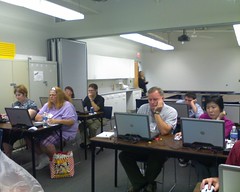Hmmm, you are reading this, so do I really have to go into what Blogs are? Well, here’s a textbook definition:
Weblog (blog) – a web page that consists of separate, diary-like entries that are arranged in a reverse chronological order, with the most recent entry at the top.
That’s it. That’s a blog. Of course, we expect certain other things from blogs these days, don’t we? At the least, they should provide an RSS feed so that we can subscribe to their content and read it through our feed readers. Oh, and most of ’em have archives and other ways to access past content as well as some sort of method for commenting on individual entries. Good ones are updated regularly with information that is timely, relevant to the audience and well-written.
Now that we’ve established what a blog is, let’s talk about what it can do for your library and your patrons. First off, it can be an amazingly efficient vehicle for communication for your library. And not one-way communication, either! Blogs generally allow readers to post comments – giving the reader some voice in the communication so that it becomes conversational as opposed to one-way announcements. For libraries that allow their patrons to post comments in an unmoderated (radical trust right there!) way, they give their patrons the feeling of openness and concern for what the patrons want and need – they tell ’em that the library is listening. Of course, if you don’t want to destroy that impression, you’ll need to post fairly regularly.
This brings us to the topic of time investment. All that writing, editing, finding the perfect picture and just plain old thinking up topics takes time. You can have one person responsible for it all, with a significant investment in time for that person, or you can split the work up and have multiple authors doing the work. Whichever way you decide to do it, there needs to be at least one person who is responsible for making sure that content reaches the blog on a regular basis. For some blogs, that will be daily – for others it may be weekly or even monthly, depending on the topic and the frequency of news about that topic. Irregular posting can cause some folks to assume the blog has died during your quiet times and unsubscribe to it – this means that they’ll miss the next big news or interesting take on a subject that is posted! At the last Internet Librarian conference, the folks behind the Hennepin County Library’s Bookspace site said that contributing to the Bookspace’s blogs was a job duty for several people – no contributions means that they aren’t doing their jobs and it will reflect on their job evaluations. That makes for some serious staff buy-in there!
Why go to all the trouble to create a blog for your library? As I said before, it opens a 2-way communication channel that is invaluable for getting patron responses to your programs, events, library news or whatever you choose to blog about. It’s also a great way to put information up onto your website that is completely reusable – and not just by you. We take our blog feed and post it on the home page of our site, just with a bit of teaser content, so that everyone who comes by our home page will see what the last 5 blog posts are. We also have a WordPress plugin that takes the blog posts and reposts them to the library’s MySpace page blog. This means that every time we post to our blog it is republished automatically to our home page and to our MySpace blog (as well as our Facebook news feed and our Twitter feed, but you get the picture…). We aren’t the only ones who could use this information, however. Since we publish our RSS feed, others can take that feed, run it through something like the new Google Feed Control Wizard and provide our blog posts as part of their website. Since we are a public library, this would be an excellent addition to a Chamber of Commerce tourism site (we have LOTS of programs going on all the time) or to a city-wide information network or to any site that wants to give their users a complete picture of what’s going on in our area. Just a bit of copy-n-paste from Google and you have an automatically updated source of information on your public library.
Blogs are even helpful if you don’t feel up to publishing one externally. An internal blog can disseminate information, provide staff with another communication tool and help teach your staff about tools that your patrons are using (feed readers, web pages, web forms, etc.). While using a free blogging service such as Blogger, WordPress.com, Vox or any of the thousands of others out there might be a bit more difficult for an internal-only blog, setting up a WordPress installation shouldn’t be too difficult for an IT department to handle. If it is, or if your IT department is reluctant to install it, give one of the blogging services that offer passwords a try. Blogger and WordPress.com do offer password protected blogs – but that’s just another password that your staff has to remember…
I could probably talkwrite for hours about how great blogs are and all of the fun things you can do with them to improve your patron/library relations, your staff/staff communications and your community/library information needs, but I’ve gotta quit sometime and this seems like a good stopping point. Anyone else want to write a book about what I’ve forgotten? OH! They have! Check out Jason Griffey and Karen Coombs new (and I do mean new – it’s not yet actually available) book about Library Blogging. Knowing those two, it’s bound to be incredibly useful and chock-full of great ideas/tips/tricks/things to remember about blogging at your library!
